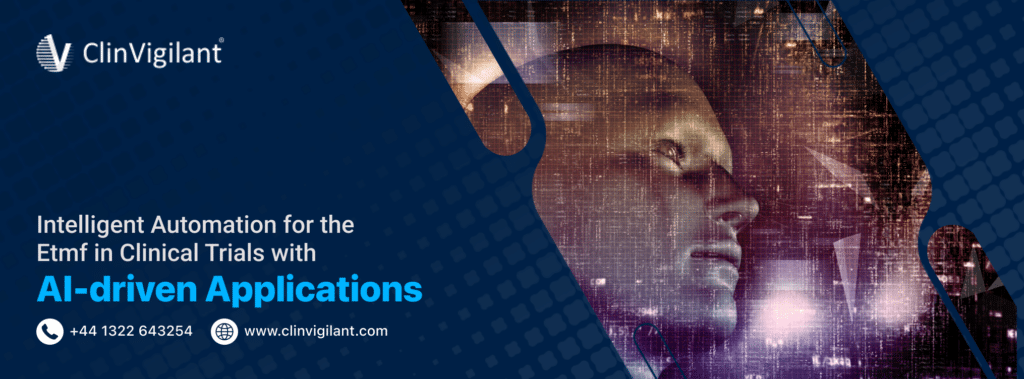
Over the last few years, the clinical trial landscape has rapidly evolved, with technological innovations playing a critical role in expediting key processes. The management of Electronic Trial Master Files (eTMF) in clinical research is one area that has seen tremendous change.
Incorporating Intelligent Automation and AI-driven applications has resulted in dramatic improvements in how eTMFs are developed, managed, and used throughout the clinical trial lifecycle. In this article, we will look at the importance of eTMF in clinical trials, the role of Intelligent Automation, and the revolutionary power of AI-driven solutions.
Understanding Electronic Trial Master Files (eTMF)
Electronic Trial Master Files (eTMF) are digital repositories that store and manage critical documents for clinical trials throughout their existence. These files include many documents, including study protocols, regulatory submissions, monitoring reports, and informed consent forms. Unlike traditional paper-based systems, eTMFs offer a streamlined and user-friendly method of organizing, tracking, and maintaining trial-related records.
eTMFs maintain regulatory compliance, increase transparency, and allow more efficient communication among diverse stakeholders, including sponsors, clinical research organizations (CROs), and regulatory agencies. These digital technologies provide real-time access to critical trial data, simplifying data management, assisting audit and inspection processes, and speeding up decision-making. As clinical trials become increasingly complicated, electronic trial management systems (eTMFs) have become critical to ensuring accuracy, efficiency, and compliance in clinical research.
The Significance of eTMF in Clinical Research
The Electronic Trial Master File (eTMF) is extremely important in clinical research since it is a comprehensive and structured repository for critical clinical trial records and information. Its impact extends beyond documentation, including trial management, compliance, openness, and collaboration. Here are some specific examples of the importance of eTMF in clinical research:
Regulatory Compliance: eTMFs are critical in ensuring compliance with regulatory standards and recommendations such as Good Clinical Practice (GCP) and International Conference on Harmonisation (ICH). A well-organized eTMF makes it easier to demonstrate compliance with these regulations during audits and inspections.
Document Accessibility: eTMFs provide all authorized stakeholders real-time access to trial documents, independent of their geographical location. This ease of access fosters collaboration among sponsors, CROs, investigators, and regulatory agencies, resulting in more efficient decision-making and communication.
Transparency: Transparency is essential in clinical research to develop confidence among stakeholders and sustain the trial’s integrity. An organized eTMF guarantees that all essential trial material is easily available, from study protocols to adverse event reports, fostering trial operations and findings transparency.
Data Integrity: By securely storing and tracking documents, eTMFs help ensure trial data’s integrity. Version control and audit trails ensure that every document change, update, or alteration is documented, resulting in an accurate historical record of the trial’s progression.
Efficient Data Management: As clinical trials become more complicated, efficient data management becomes increasingly important. eTMFs automate the process of document storage, organization, and retrieval, lowering the risk of errors, lost documents, and data duplication.
Facilitating Audits and Inspections: Audits and inspections are critical to preserving clinical trial quality and credibility. A well-maintained eTMF speeds up these processes by providing auditors and inspectors instant access to the necessary papers, resulting in smoother and more efficient evaluations.
Risk Management: eTMFs aid in the identification of potential risks and deviations during a study. By centralizing all trial-related documentation, sponsors, and CROs may better identify and resolve any developing concerns, hence improving risk management techniques.
Decision-Making: eTMFs provide stakeholders with a thorough overview of trial progress, allowing them to make educated decisions. Sponsors and investigators can make timely and well-informed decisions about the trial’s path if they can access up-to-date documentation and data.
Collaboration: Effective collaboration among the numerous stakeholders in a clinical study is critical. eTMFs promote collaboration by offering a common platform for authorized users to read, review, and contribute to documents, resulting in more efficient teamwork.
Reduced Administrative Burden: eTMFs’ automation and digital organization feature lessen the administrative load associated with manual document processing, allowing clinical teams to focus on more strategic aspects of trial management.
Efficient Archiving: Proper archiving of trial papers after the trial is concluded is critical for long-term compliance and any future references. eTMFs make this procedure easier by storing all trial-related documents digitally and in one place.
Cost and Time Savings: The streamlined processes offered by eTMFs result in cost and time savings: reduced manual handling and faster access to documents.
AI-driven Applications in eTMF Management
AI-powered technologies are transforming clinical trial management of Electronic Trial Master Files (eTMF). These solutions add unparalleled efficiency, accuracy, and insights to the eTMF operations by using the power of Artificial Intelligence (AI) and powerful data analytics. Here’s how artificial intelligence-powered applications are revolutionizing eTMF management:
Predictive Analytics: AI systems examine historical trial data to forecast potential bottlenecks, dangers, and deviations. These systems offer proactive decision-making by spotting patterns and trends, allowing stakeholders to resolve concerns before they escalate.
Natural Language Processing (NLP): NLP-powered systems derive important insights from unstructured text within documents. This covers sentiment analysis, key term identification, and information categorization. Document indexing, searchability, and trend analysis are all improved by NLP.
Automated Document Categorization: AI-based algorithms can automatically categorize and tag documents based on their content, minimizing the amount of manual effort required for effective document placement inside the eTMF. This guarantees that documents are properly organized, which improves organization and accessibility.
Risk Assessment: AI analyzes trial data to identify potential risks and compliance concerns. It aids in detecting abnormalities, the correctness of data, and the overall quality of documents and procedures within the eTMF.
Cognitive Search: Search engines improve document retrieval by recognizing context and purpose. This saves time and effort when searching for specific information within the eTMF, which is especially useful during audits and inspections.
Data Validation and Quality Control: AI-powered apps validate data automatically by comparing it to predetermined criteria. This decreases data entry errors while improving trial data’s accuracy and dependability within the eTMF.
Trend Analysis: AI analyzes trial data to detect emerging trends and patterns that would be missed by manual analysis. This data can inform decision-making, protocol changes, and future trial preparation.
Decision Support: AI delivers contextual information and recommendations to assist decision-making. For example, it can recommend ideal investigator selections depending on trial requirements, allowing for more informed and strategic decisions.
Adaptive Learning: AI systems can learn from trial data to improve their predictions and recommendations over time. This adaptive learning means that the AI system becomes more precise and effective as the trial goes.
Reduced Administrative Burden: AI-driven solutions allow clinical teams to focus on more strategic and value-added operations by automating routine chores such as document sorting, data extraction, and validation.
Real-time Reporting and Dashboards: AI provides real-time reports and dashboards that provide information on the eTMF’s status. This visual depiction assists stakeholders in tracking progress, identifying trends, and making timely, informed decisions.
Enhanced Compliance: AI-powered applications help assure regulatory compliance by highlighting irregularities, non-compliance events, and potential data integrity issues. This improves the trial’s documentation’s accuracy and reliability.
Integrating AI-powered applications into eTMF administration improves efficiency, accuracy, and data-driven decision-making. As AI’s capabilities grow, its potential to transform clinical trial management through enhanced automation and better analytics becomes clearer.
Conclusion
Using Intelligent Automation and AI-driven solutions in eTMF management has transformed the clinical trial landscape. These tools improve trial efficiency, transparency, and compliance by speeding processes, minimizing errors, and giving actionable insights. The synergy between technology and clinical research will lead to creative solutions that redefine the future of eTMF management, benefiting all stakeholders involved in the pursuit of safer and more effective treatments as the field evolves.

